We invite you to join NASA CONNECTS!
You can join as a formal K-12 educator or as a professional in the informal education (out-of-school time) field. If you have a Gateway account, click the button below to log in through NASA Gateway, then register to join NASA CONNECTS. If you do not have a NASA Gateway account, you will need to create one before joining this community of practice by clicking the button below and following the prompts.
Visit the website https://nasacentral.force.com/cop/s/
What are the benefits you may ask?
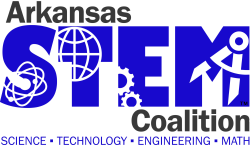
The Arkansas STEM Coalition received 110 television monitors from Arkansas Children’s Hospital to support student learning in STEM Education, Science, Technology, Engineering, and Mathematics, for schools throughout Arkansas.
The Arkansas STEM Coalition will distribute monitors in September and October to each of the 12 University STEM Centers in Arkansas and each of the 15 Educational Service Cooperatives. Additional monitors will be distributed to rural school districts in critical need of technology devices.
Dr. Suzanne Mitchell, Executive Director of the Arkansas STEM Coalition said, “this is a strategy to provide additional technology to facilitate student learning. The monitors will be used by students to enhance science and mathematics content learning, to engage student teams in support of computer science and robotics competitions, and to increase productivity of technology devices.”
eSCO Processing and Recycling Company, a partner in the project, will coordinate the pick-up, storage, and testing of the units. Joe Tucker, Vice President at eSCO, said, “We’re happy to play a part in this partnership. Getting refurbished electronics into the hands of Arkansas educators and students is a top priority for our company.”
Joe Knight, Environmental Management Coordinator at Arkansas Children’s Hospital, said, “We needed to update the televisions in patient rooms and to recycle these working units. Children need access to good technology, and these gently used monitors will be beneficial for many schools.”
Dr. Mitchell said, “the Arkansas STEM Coalition began in 2010 as a 501c(3) nonprofit and is a statewide partnership of business, education, government and community leaders who support policies, strategies, and programs for excellence in STEM education. The STEM Coalition is a catalyst providing inspiration and opportunity for students, kindergarten through college, to ensure a well-trained, STEM-skilled Arkansas workforce.” Contact the Arkansas STEM Coalition at 501-425-9995 or www.arkansasSTEMcoalition.com.
The Arkansas Department of Education Office of Computer Science is pleased to announce the winners of our Innovation in Computer Science School Grant Program announced via Commissioner’s Memo COM-21-055 on December 10, 2020 https://adecm.ade.arkansas.gov/ViewApprovedMemo.aspx?Id=4621. The following 16 schools were selected from a total of 30 applicants, based on proposals that indicated efforts to expand their computer science program and implement innovative best practices and will each receive grants totaling $207,722.94 from the Arkansas Department of Education Office of Computer Science.
Beryl Henry Elementary in Hope – $24,856.00
Yellville-Summit High School in Yellville – $24,050.00
Rose Bud High School in Rose Bud – $22,560.89
Greenbrier Junior High School in Greenbrier – $19,877.00
Harrison High School Conversion Charter in Harrison – $19,650.00
Bauxite High School in Bauxite – $19,311.00
Elkins High School in Elkins – $19,178.43
Fouke Elementary School & Paulette Smith Middle School in Fouke – $12,826.67
Mineral Springs High School & Elementary School in Mineral Springs – $10,829.73
Arkansas Virtual Academy Elementary and Middle School in Little Rock – $8,000.00
Carlisle High School in Carlisle – $7,496.32
Harrisburg High School in Harrisburg – $6,754.32
Westside High School in Jonesboro – $5,715.00
Perryville High School in Perryville – $3,719.38
Valley View Public Schools in Jonesboro – $2,549.20
Magnet Cove Middle School in Malvern – $349.00
The listed recipients will use the funds to cover the expenses associated with purchasing curriculum, software licenses, and non-fundamental equipment, and provide professional development or student incentives, as outlined in their submitted budgets. Final awards are subject to grant performance and the approval of the Division of Elementary and Secondary Education.
Taken from: https://adecm.ade.arkansas.
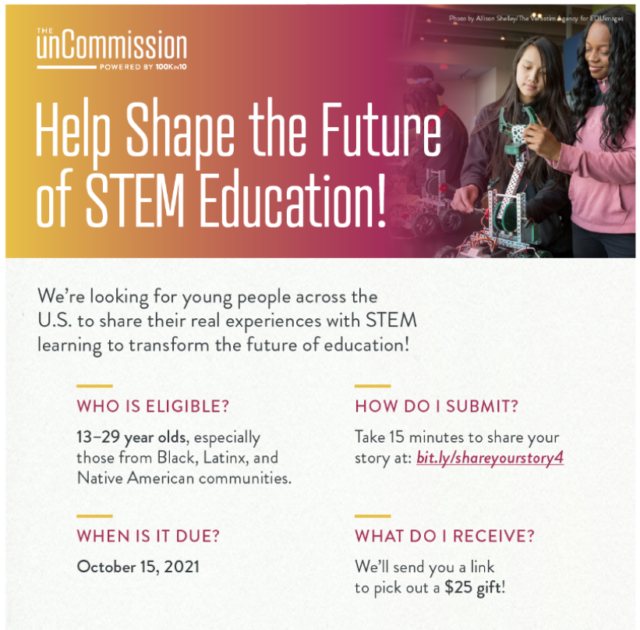
The unCommission is a massive, diverse, and participatory experience that will determine the next set of transformative goals for preK-12 STEM education. We are bringing together hundreds of young people across the country, with a focus on those most excluded from STEM opportunity, to share their personal experiences and stories about science, engineering, technology and math. From these stories, we will distill insights and develop a constellation of goals for the future of STEM education.
We hope to hear from as many young people as possible by October 15, 2021. To show our gratitude, we will send all storytellers a link to select any of these gifts after they submit a story.
Who is a Storyteller?
A storyteller is any young person aged 13-29 who wants to share their real experiences in STEM learning in the United States to help reveal the most important themes and patterns related to STEM education. We are especially hoping to hear from those furthest from inclusion in the STEM fields, particularly Black, Latinx, and Native American communities.
What is a Story?
Stories are accounts of your experiences with STEM learning — there are no right or wrong answers! Stories can feel joyful, apathetic, or sad. They can be a typed letter (max 500 words), a handwritten letter (max one page), or an audio or video journal (max 4 minutes).
What will the unCommission do with these stories?
Once stories are submitted, they will be read and listened to by trained researchers, who will pull out themes and patterns from the hundreds of stories that are collected. These insights will be turned into new national education goals for the country that the unCommission will share broadly–including with the Biden Administration!
How to Add Your Voice
There are two ways for young people to share their STEM story (Note: 13-17 year olds MUST get parental consent before submitting a story. To get consent simply log onto the platform — it will prompt you and/or your guardian/parent through the process.):
1) Storytellers can submit a story anytime by creating a profile on the unCommission storytelling platform and responding to the following prompt: “Describe an experience you had in science, math, engineering, and/or technology, inside or outside the classroom, from pre-K-12th grade. How did you feel in that experience, and what made you feel that way?” (Estimated time commitment: 15 minutes)
2) Storytellers can attend one of the below Story Hours hosted by 100Kin10. These Story Hours are an opportunity for storytellers to learn more about the unCommission and get support creating their story. Register in advance below! (Estimated time commitment: 1 hour)
For storytellers ages 18-29:
- Tuesday, September 14, 8-9 pm ET
- Saturday, September 25, 3-4 pm ET
- Tuesday, September 28, 5-6 pm ET
- Wednesday, October 6, 7-8pm ET
For storytellers ages 13-17:
- Tuesday, September 14, 5-6 pm ET
- Saturday, September 25, 2-3 pm ET
- Tuesday, September 28, 7-8 pm ET
- Wednesday, October 6, 6-7pm ET
Questions? Reach out to [email protected].
Have you ever dreamed of crossing the ocean and exploring the mysteries of the sea? Well, here is your chance! Follow the fun steps below and “sea” if you have what it takes to invent your way across the water while trying not to bump into (or step on) sea life!
Original Source: National Inventors Hall of Fame
Materials Needed
- Crafting materials
- Craft paper
- Die
- Recyclables
- Tape (masking or painter’s)
- Two plastic bags
Step-by-Step Instructions:
- Find a large open space and create an enclosed shape using tape.
- Using craft materials and recyclables from around your home, create ocean animals and plants!
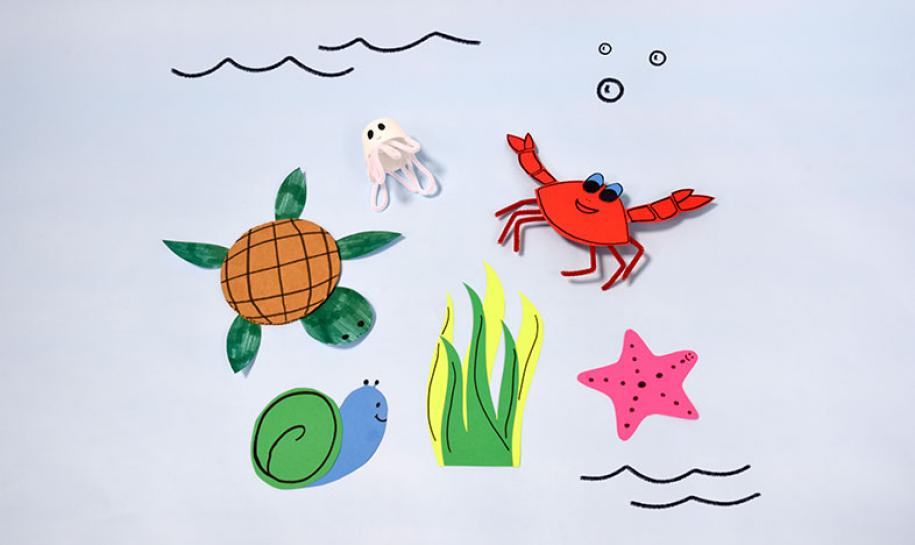
- Place them in your enclosed shape.
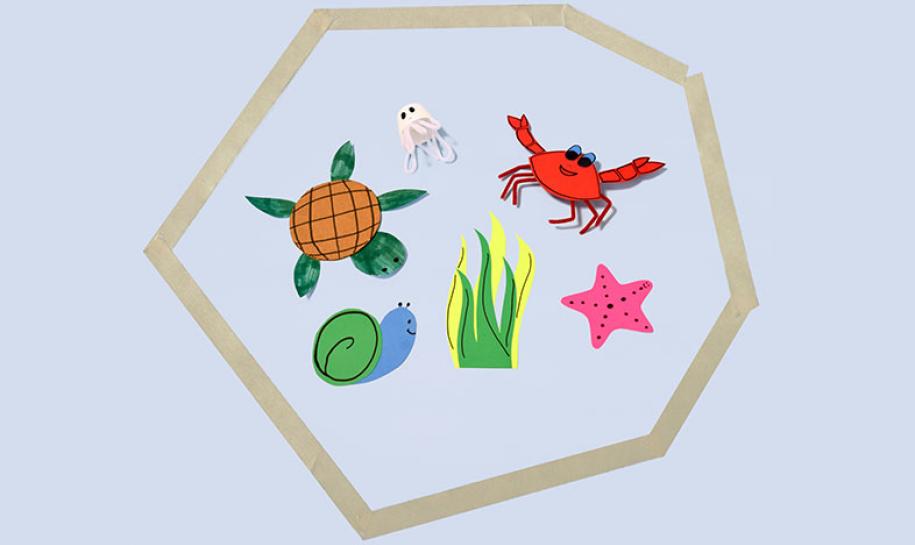
- Lay both plastic bags flat with the blank sides facing up.
- Decorate the blank sides of the bags.
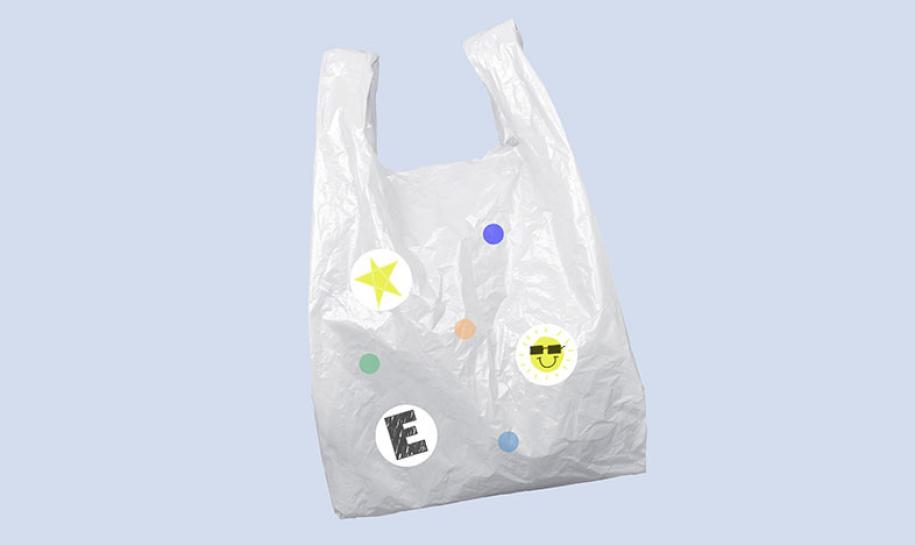
- Using the handles, take one bag and slip it onto your foot so the decorations are facing up.
- Tie the two handles together above your ankle.
- Repeat the above steps to properly secure the second bag on your other foot. Unsure if the bag shoes are your scuba style? Try making your own waterproof shoes using other materials from around your home!
- Roll the die once and use the guide below to see what each number indicates. This is how you will cross the sea.
- 1 – Hop
- 2 – Walk backward
- 3 – Use one leg
- 4 – Skip
- 5 – Dance
- 6 – Crabwalk
- Did you avoid bumping into or stepping on sea life? You get one point! Accidentally stepped on a flipper? Wait for your next turn.
- Each time you cross the sea, roll again and try taking a new path. The first player to get 10 points wins! (You can also play on your own and challenge yourself by using a timer!)
- Want a bigger challenge? Add some items into your sea that do not belong, like stuffed land animals or plastic items, and then create an invention to lift and clean them out of the sea.
What Are We Discovering?
People have always been fascinated with what is hidden beneath the surface of the ocean. National Inventors Hall of Fame® Inductee Harold Froehlich is the inventor of the longest operating deep-sea submersible, Alvin. Owned by the U.S. Navy and operated by Woods Hole Oceanographic Institution, Alvin took its first dive in 1964. In 1974, Alvin allowed scientists to map the Mid-Atlantic Ridge, which helped confirm the theory of plate tectonics and continental drift. In 1977, Alvin took scientists down 9,000 feet off the coast of the Galapagos Islands, where they found aquatic species like the giant tube worm — one of about 300 new species of animals whose discovery was enabled by Alvin. In 1986, Alvin made possible the first pictures of the sunken RMS Titanic. Alvin has also assisted with environmental waste studies and missions.
Check out this fun ‘Bubble Construction Design Challenge’ activity from Family Science & Engineering!
|
|
|
According to fellow scientist, Joseph Priestly, Ben Franklin performed his famous kite experiment in June 1752. Franklin had been interested in “electric fire” for quite a while and had an on-going dialogue with other scientists of his day about the phenomenon. His famous key experiment established that lightning was a form of electricity.

There are a couple of myths about this famous experiment though. First, the kite experiment did not help Franklin “discover” electricity. Humans had known about electrical forces for more than a millennium. What it did do was establish the connection between electricity and lightning, and it ultimately led to Franklin’s refinement of the of the lightning rod. These devices are still used today on taller buildings to help channel the electric charge from a lightning bolt safely to the ground.
Also, neither Franklin nor the kite were actually struck by lightning. (He likely would have died if either had happened!) The wet hemp string that he attached to the kite was a good conductor of electricity, and they key attached to the string picked up electrical charge from the air in the active storm.
While we would not recommend that you replicate Franklin’s experiment, there are some easy ways to investigate static electricity at home and remember Franklin’s contributions to STEM.
Static Electricity Race
You’ll need: two aluminum cans, some masking tape, and two balloons.
Here’s what you do:
- Using masking tape, mark a “start” and a “finish” line on the floor about 1 yard (1 meter) apart.
- Place 2 empty soft drink cans on their sides on the starting line.
- Inflate and tie-off 2 balloons. To charge the balloons, rub them rapidly back and forth on your clothing for a minute.
- When you’re ready for the race, hold the balloons near the cans, without touching them to the cans, and have someone say “go.”
- Each person tries to move his/her can across the finish line using only the static electricity of the balloon. Don’t touch the balloons to the cans!
- After the race, ask participants what caused the balloons to move? (Static electricity – charged particles you rubbed off your clothes and onto the balloon.) Then ask if they can identify whether the part of the can nearest the balloon had similar or opposite charges. How could they tell? (Opposite charges attract. Like charges repel.)
Have fun!
Be sure to check out more from Family Science & Engineering guidebook for more ideas to inspire engineering exploration!
Arkansas STEM Coalition
The Arkansas STEM (Science, Technology, Engineering, and Math) Coalition is the statewide hub of STEM information, created through a robust partnership of leaders from the corporate, education, government, and community sectors. Together we encourage, coordinate, and advocate for policies, strategies, and programs supporting excellence in STEM education and creating pathways to high-demand, highly-skilled, higher-paying jobs that expand the economy of Arkansas.
Contact Us
Phone: 501-425-9995
Email: [email protected]
Physical Address: 401 South Scott Street, Nonprofit Center #1, Little Rock, AR 72201
Mailing Address: PO Box 3142, Little Rock, AR 72203

